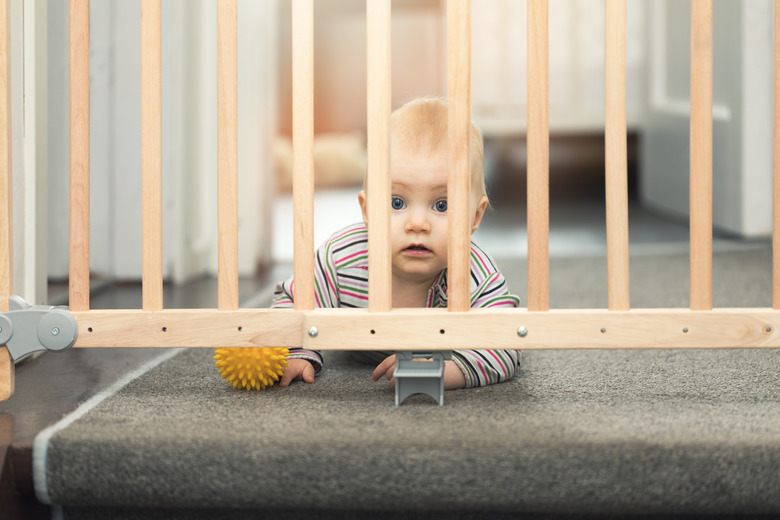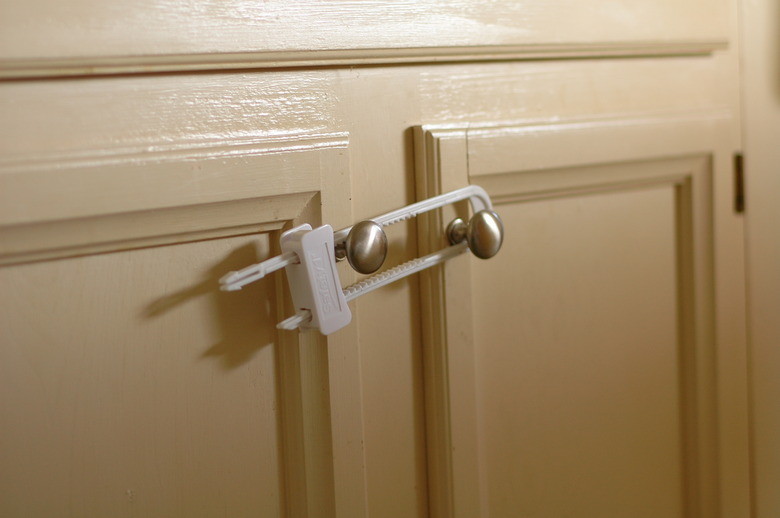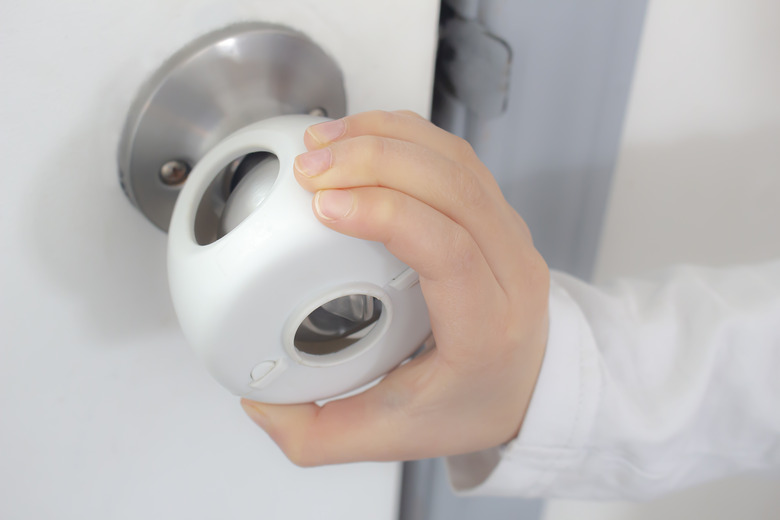How To Prep Your Home For Baby: Babyproofing Basics
We may receive a commission on purchases made from links.
Although it seems unimaginable that the peaceful newborn in your arms (or perhaps the baby still kicking in your belly) will someday turn into a crawling, walking, trouble-seeker, but it's best that you — and your home — are prepared for the curiosity of a toddler. While it's certainly a big part of the project, babyproofing efforts shouldn't be limited to simply buying and installing some safety latches, door locks and similar products. In fact, the first step of babyproofing is to take a close look at every part of your home and determine any potential risks that could put your child in danger.
It's important not to just add safety equipment to prevent your child from accessing hazardous areas of your home but also to do things like turn down the temperature on your hot water heater and eliminate potential strangulation or choking hazards.
When to Start Babyproofing
When to Start Babyproofing
Most babyproofing projects need to be complete by the time your infant starts crawling, but that doesn't mean you should wait until your baby starts moving on all fours to start taking action. In fact, it is often a good idea to start babyproofing before your bundle of joy is even born — since you're likely to have a lot more mental and physical energy before you have someone crying for your attention all day and all night, especially if you're a first-time parent.
Buying Babyproofing Products
Buying Babyproofing Products
There are many places to buy childproofing products, like home improvement stores, grocery stores, mass merchandisers like Walmart and Target and, of course, online marketplaces. While you can buy them in person while doing your other shopping, many of these products vary in quality or are useful only for specific applications, so it is often advisable to shop online, where you can read user reviews to ensure you get something that will actually keep your baby safe.
As an example, there are many different drawer latches, and depending on your cabinet type, DIY experience and personal preferences, you might want one of the following:
- A device
that links cabinet handles together - A set that adds knobs to the outside of your cabinet that lock together
- A lock that
requires a magnetic key for entry - A strap lock that goes around the corner of the cabinet or one that needs to
be pressed down before the cabinet can be pulled open.
Similarly, while most door knobs can be fitted with standard spinning knob door locks, door levers require special locks, as do sliding doors, and you may even want a door lock that can prevent little fingers from getting pinched in the door. It can often be tough to figure out which option is right for your home, but the reviews and more extensive product details available online can help you better understand what features work best for your situation (and save you time since you won't have to return an unusable product).
Hiring a Professional Babyproofing Service
Hiring a Professional Babyproofing Service
While most people opt to babyproof their homes themselves, some people find extra comfort by working with a professional. Even if you think you can do the work yourself, a consultant can take a look at your home and recognize problem areas for less than $100. In fact, most professional babyproofers start with a consultation that identifies potential risks, recommends the best products for the job and offers you the option to choose which services you would like him to handle on your behalf and which you would like to tackle yourself.
A professional consultant has unique expertise that can ensure you are not only alerted to all potential hazards in your home but also informed of the best baby-safety items for your specific situation. These personalized product picks mean your childproofing products should last for years — often until you don't need the products anymore.
For those who don't feel comfortable screwing safety latches into their cabinets and installing safety straps that will connect the television to the wall, a babyproofing service can make your entire home secure enough for your little one while addressing your concerns about breakables, valuables and antiques. That's because experts in this type of work can install safety products for your furniture, cabinetry and walls with minimal damage, so there are fewer risks to your high-end and vintage items.
How to Identify Home Hazards for Babies
How to Identify Home Hazards for Babies
If you don't want to hire a consultant to assess potential risks in your home, you'll need to tackle this step yourself. Don't just walk through each room at your own height to look for potential dangers; remember to get down on the ground and see things from your baby's perspective.
A comprehensive home hazard check will usually include the following:
- In your kitchen, you'll need to install
knob covers on your stove, an oven lock and cabinet locks under the kitchen sink to keep your child away
from dangerous cleaning products. - In the bathroom, add cabinet locks under the
sink, use locks on your toilets, place nonslip stickers on the tub and install a spout cover on the bathtub faucet. - While your child is unlikely to be anywhere near your hot water heater, don't forget to turn it down to 120 degrees.
- Look for things such as blind cords that may present a
strangulation risk, any breakable or heavy items that could easily be knocked
off furniture or pulled down with a tug. - Check for furniture that could be pulled down if not
properly anchored to the wall or choking hazards. - Look for
sharp edges and sharp corners on tables, shelves and walls that should
be fit with corner guards to protect young toddlers who often fall while learning to walk and
stand.
Remember that it's OK to have adult-only rooms with breakable antiques, a glass-topped coffee table and unanchored furniture as long as you prevent your child from entering the area by using safety gates or childproof door locks to prevent your youngster from getting into the room.
Watch the Windows
Watch the Windows
While windows might not seem particularly dangerous to adults, even a small fall can be dangerous to an infant. In fact, around eight children die and 3,300 kids are injured by falling from windows every year, making windows one of the top five hazards to children under the age of 5, so keep these in mind while childproofing your home. Keep windows closed when young children are around, keep furniture away from windows so kids can't climb out of them and use window guards to prevent falls. That being said, avoid blocking off windows entirely because they can often prove to be the only means to safely escape a home in the event of an emergency, such as a fire.
Outlet Covers and Cords
Outlet Covers and Cords
You likely know you should cover electrical outlets to help prevent young children from accidentally shocking themselves. What many people don't realize, though, is that traditional plastic outlet covers can present a choking hazard. So, rather than using plastic plug covers, invest in sliding outlet covers that are permanently affixed to the wall with a screw, making them more childproof against young hands and mouths.
It's worth mentioning that if you have a home built after 2008, you likely have tamper-resistant outlets already installed in your home. These outlets are specially designed to reduce the likelihood of shock injuries to children by only opening when two prongs from a cord are inserted at the same time. However, because children may imitate their parents and plug in dangerous appliances otherwise left unplugged (such as curling irons, paper shredders or irons), it's still a good idea to install sliding outlet covers on these outlets to keep your little one safe.
If you have any plugs that must remain in the outlets (for example, those that power light fixtures or a desktop computer), further reduce shock hazards by securing the plugs in place with a plug guard that will prevent your child from pulling out the cords. You can also secure cords to the wall with a cord cover to help reduce strangulation hazards.
Secure the Crib Area
Secure the Crib Area
Infants spend up to 18 hours sleeping, so pay particular attention to your child's sleeping area — there should be no gaps between the crib mattress and the crib itself, and you should never use baby bumpers, plushies, quilts or pillows in an infant's crib, as these can all present suffocation hazards. Use a cordless baby monitor or ensure its cord is always at least 3 feet away from the crib so the baby cannot strangle herself with the cord. Don't hang heavy art or mirrors above the crib rails.
Make sure floor lamps and curtains can't be reached from the crib. Don't ever put a crib next to a window and avoid placing it under an air vent because the air from a heater and air conditioner can make it difficult for an infant to regulate her body temperature.
Areas Requiring Special Attention
Areas Requiring Special Attention
Kitchens and bathrooms present more hazards than most other rooms. Be sure to keep these areas closed off from your infant when you are not present. Use childproof locks to keep the bathroom closed and close off the kitchen with baby gates. Even when you've taken these extra precautions, be sure to do the following:
- Store dangerous chemicals in a locked cabinet and keep sharp items,
such as knives, secured in a babyproof drawer or cabinet. - When cooking, try to
use the back burners when possible and never leave pan handles dangling over
the edge of the stove where they can be easily pulled down by curious hands. - If you have stairs, take extra care to limit the fall risk
to your child. Install baby gates at the top and bottom of the stairs and only
use screw-in gates on the stairs, not those that are secured with pressure
since they can be pushed over. - When your baby gets old enough, do some
supervised practice time on the bottom steps to help familiarize him with how
to climb the steps before securing the gate again. - Install railing guards if you have balusters that are more than 3.5 inches wide, as kids
often get their heads trapped in these spaces. - Fireplaces can also present numerous hazards, so be sure to install
a fireplace door lock and place corner guards along any brick corners. Alternatively, use a baby
gate to keep your child away from the fireplace entirely. - Be sure to remove dirty or sharp fire tools as well as matches from areas where children can reach them.
Never Rely on Babyproofing Alone
Never Rely on Babyproofing Alone
The idea behind childproofing your home is to ensure your baby won't get hurt by common household dangers so that your little one can explore her surroundings safely. However, you still need to keep an eye on your baby no matter how many child safety measures you install around the home. Don't ever leave your baby alone unless she is secure in her crib or playpen. Always use the safety straps when your child is in her changing table or in her high chair and keep one hand on your infant when changing her diaper.
Take an infant first-aid course so you know what to do if your child is injured. Program the phone numbers for your local poison control center and fire department in your cell phone and post the numbers in a visible area near any landline phones as well. Be sure you have carbon monoxide detectors and smoke alarms on every floor of the house as well as one in every bedroom of the home, particularly the room where your child sleeps.
References
- BabyCenter: How to Buy Childproofing Products
- American Academy of Pediatrics: Scalding Water Temperatures
- Primrose Schools: The Pros and Cons of Hiring Professional Baby-Proofers
- Family Education: Babyproofing Basics: The Top Hazards in Your Home
- WebMD: Baby Proofing Essentials
- Natural Baby Life: Don't Put the Crib in Front of the Window (Until You Read This!)
- What to Expect: Babyproofing Your Home: A 6-Step Program
- What to Expect: Babyproofing the House: A Guide to Keeping Your Child Safe
- Parenting: Babyproofing Basics
- Project Nursery: 9 Baby Proofing Basics
- National Safety Council: Windows are Vital to Survival, but Keep Safety in Mind
- Parents: Babyproofing Basics
- Childproofing Experts: Childproofing Outlets in Your Home


